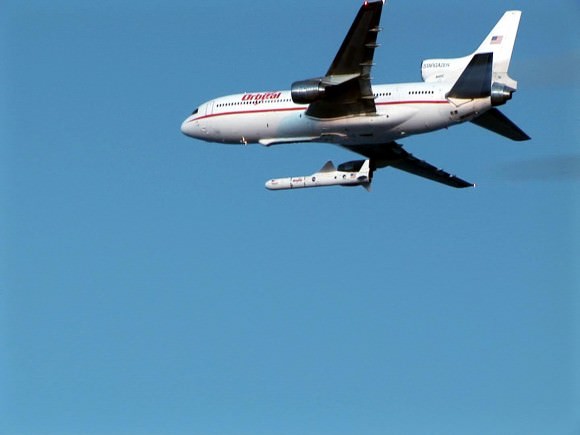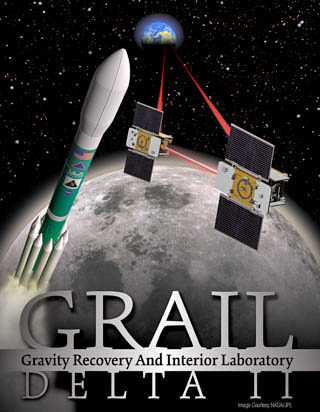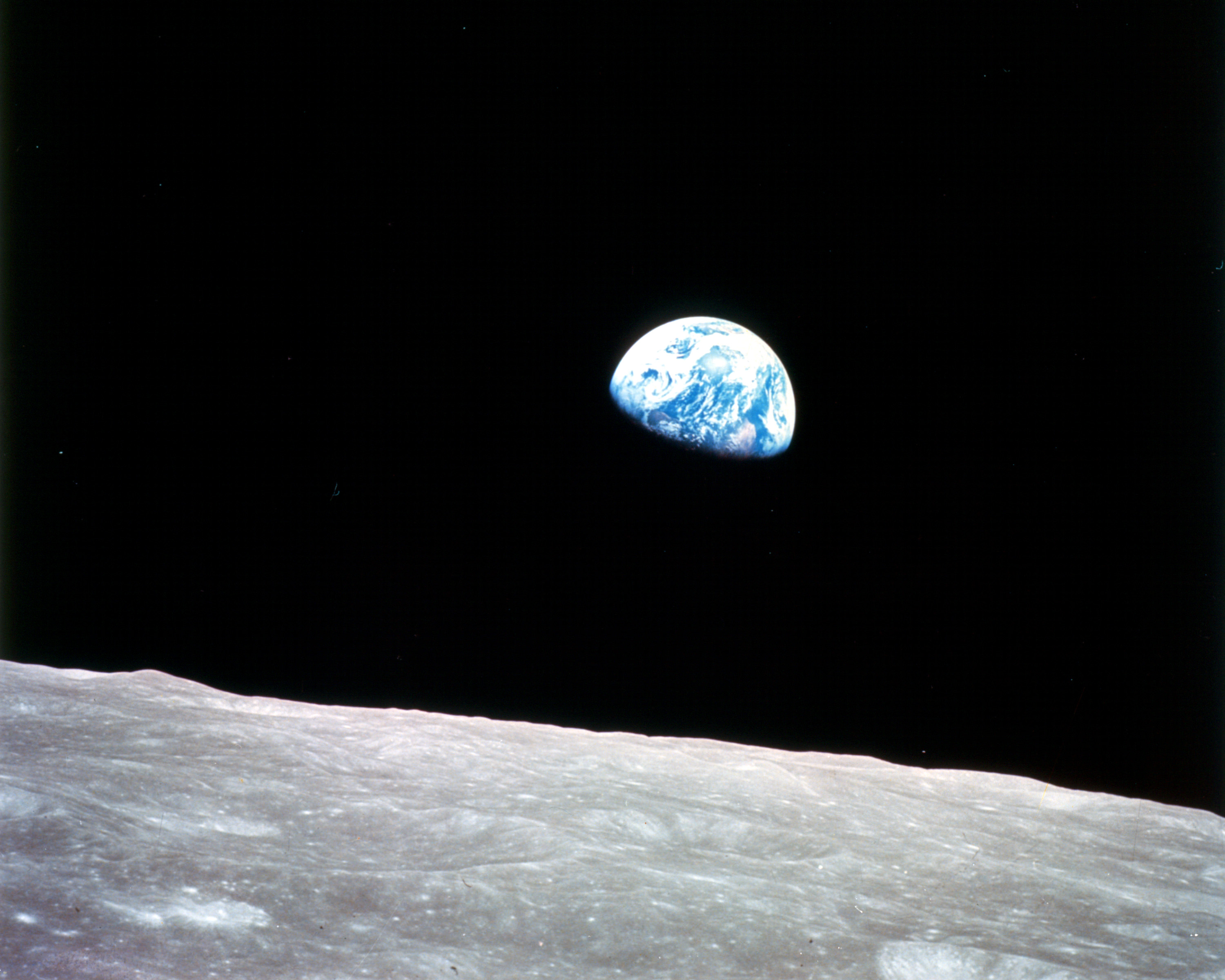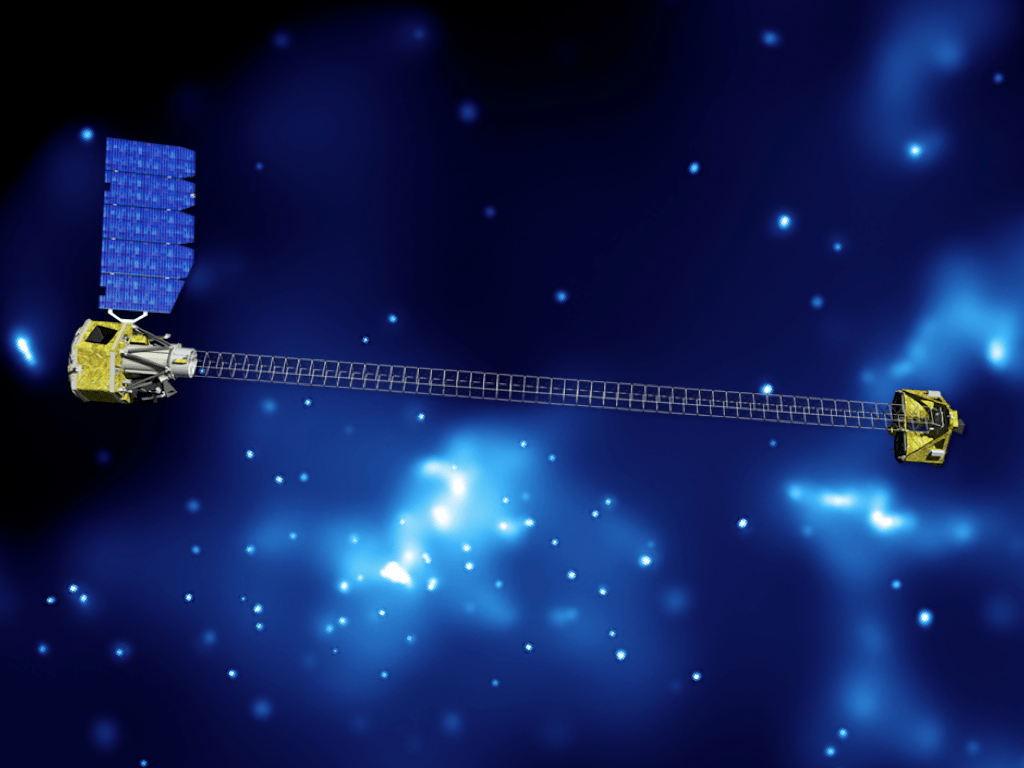En route to the Red Planet, Mars rover Curiosity has experienced the strongest solar radiation storm since 2005. No need to be alarmed: Researchers say it’s all part of Curiosity’s job as a ‘stunt double’ for human astronauts.
Phoenix Lander Still Visible in New HiRISE Images from Mars
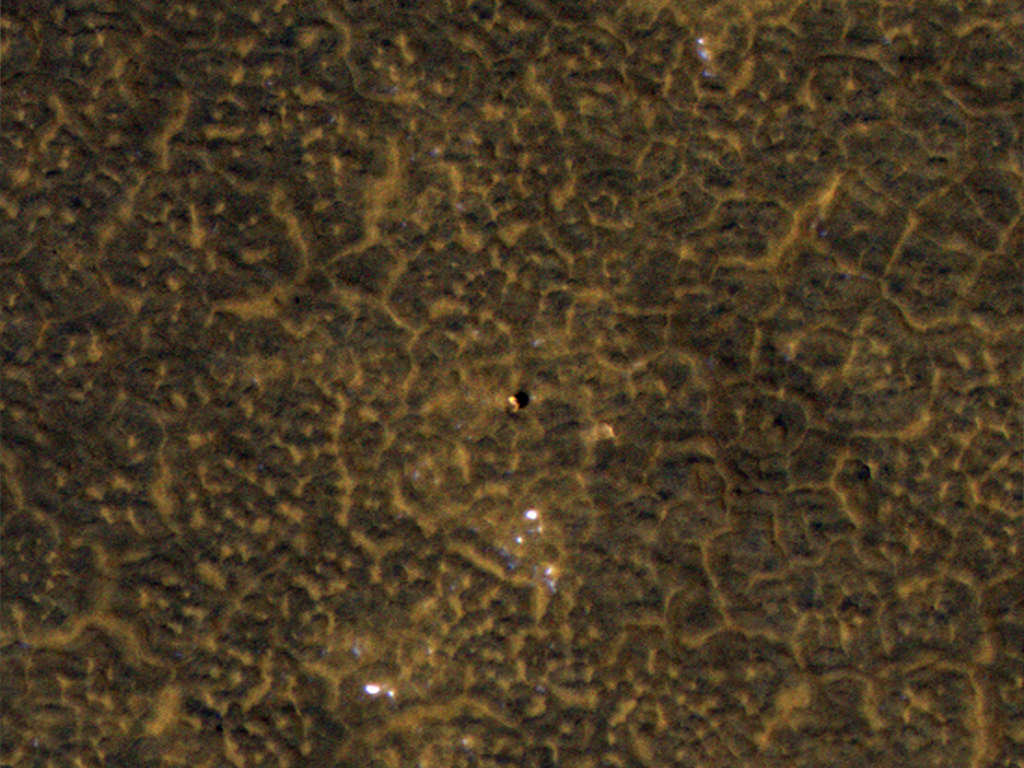
[/caption]
I spy Phoenix! said the HiRISE camera on board the Mars Reconnaissance Orbiter! This new image acquired on January 26, 2012 shows that the Phoenix lander and its backshell are still visible from Mars’ orbit. The parachute, seen in earlier images, is probably about 130 meters south of where this picture ends. This is one of a series of images to monitor frost patterns at the Phoenix landing site, said HiRISE Principal Investigator, Alfred McEwen, adding that this new images shows almost the same appearance of the hardware as 1 Mars years ago, in 2010. See larger versions of this image at the HiRISE website.
See below for comparison images from orbit from 2008, shortly after Phoenix landed and 2010, after the mission had ended.
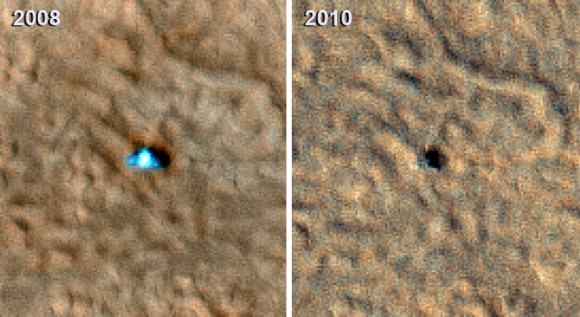
In these images, also from the Mars Reconnaissance Orbiter, signs of severe ice damage to the lander’s solar panels show up in the 2010 image, with one panel appearing to be completely gone. The Phoenix team says this is consistent with predictions of how Phoenix could be damaged by harsh winter conditions. It was anticipated that the weight of a carbon-dioxide ice buildup could bend or break the solar panels.
Source: HiRISE
A Bouncing Moon Boulder
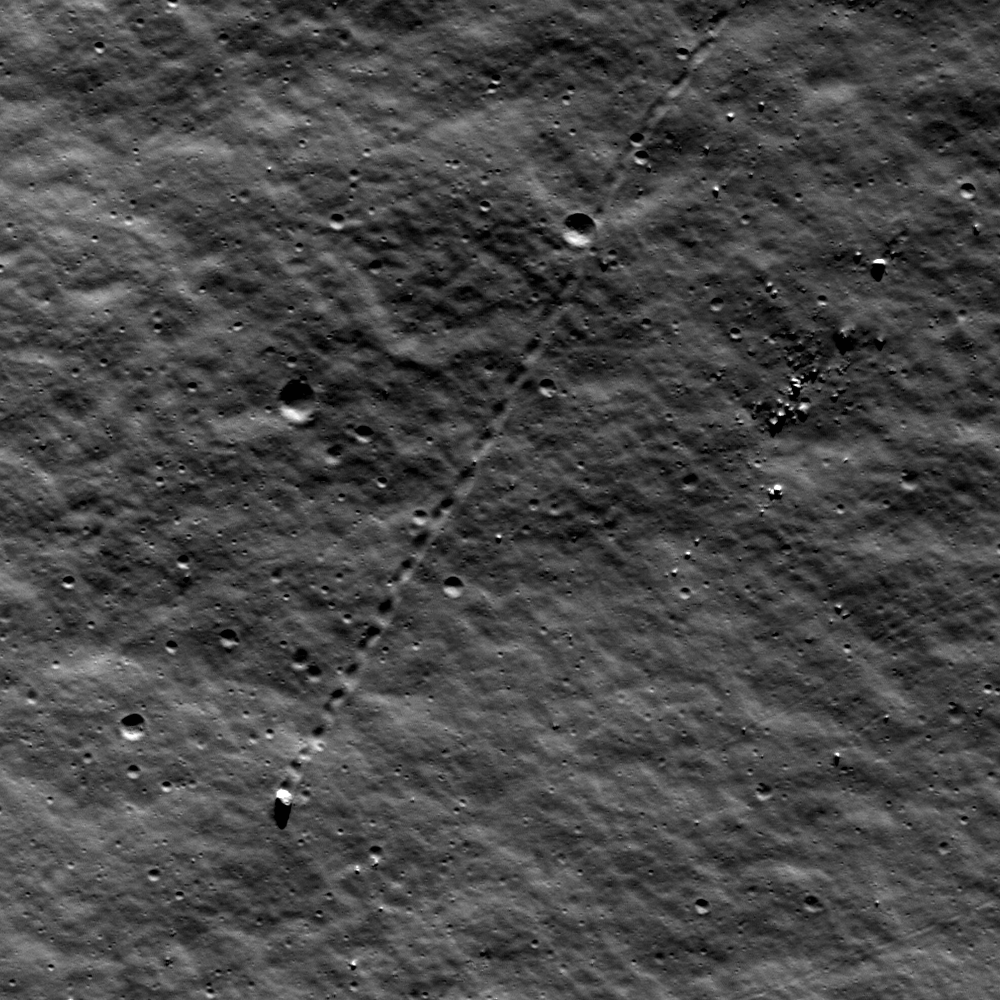
[/caption]
One solitary boulder on the Moon apparently decided to take a little journey. The Lunar Reconnaissance Orbiter Camera captured the track of a bouncing, rolling 9-meter boulder that used to sit along the rim of a crater. From the pristine nature of the tracks, it might seem that the rock may have taken its trip just recently. But with the high resolution capability of the LROC, scientists can see that a few tiny craters are superimposed among the track and therefore post-date the time the boulder traveled. Scientists estimate this track was created 50-100 million years ago.
“Though long ago to humans, however, this boulder’s journey was made in geologically recent times,” wrote lunar scientist James Ashley on the LROC website. “Studies suggest that regolith development from micrometeorite impacts will erase tracks like these over time intervals of tens of millions of years…Eventually its track will be erased completely.”
What might have caused the rock to roll so recently? Ashley said perhaps this boulder was sent on its way by ground-shaking caused by the violence of a nearby impact. Perhaps a direct hit by a small meteoroid did the job.
This isn’t the first time LRO has captured evidence of “moving” rocks. See our previous article about several other images of bouncing boulders.
Source: LROC
Incredible 3-D View Inside a Martian Crater
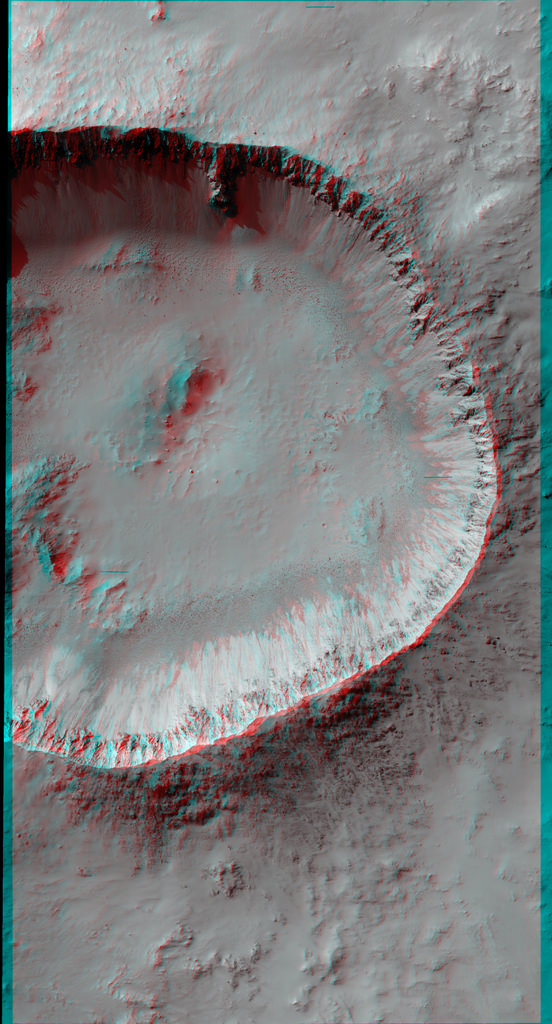
[/caption]
This is why I always keep a pair of 3-D glasses by my computer. This well-preserved crater on Mars may look like just your average, run-of-the-mill impact crater in 2-D, but in 3-D, the sharply raised rim, the deep, cavernous crater body, and especially the steep crater walls will have you grabbing your armchairs so you don’t fall in. The image is courtesy of the HiRISE camera team from the Mars Reconnaissance Orbiter. This unnamed crater is about 6 or 7 kilometers wide from rim to rim. HiRISE took the image on New Year’s Eve 2011.
HiRISE principal investigator Alfred McEwen says that the camera has imaged hundreds of well-preserved impact craters on Mars ranging from 1 meter to more than 100 kilometers wide. What can the scientists learn from craters?
“These targets are of great interest for multiple reasons,” he said. “First, we want to better understand impact cratering, a fundamental surface process. Second, such craters often contain good exposures of bedrock in the steep walls and, if the crater is large enough, in the central uplift. Just like terrestrial geologists are attracted to good bedrock outcrops like road cuts, planetary geologists are attracted to well-preserved craters.
“Third, the steep slopes often reveal active processes, such as formation of gullies, boulder falls, and slope streaks that could form in a variety of ways. Some of these active processes could be related to water, since the crater may expose lenses of ice or salty water, or create deep shadows that trap volatiles, or expose salts that can extract water from the air.”
Plus, they are just plain wonderful to behold, especially in the resolution the HiRISE can obtain.
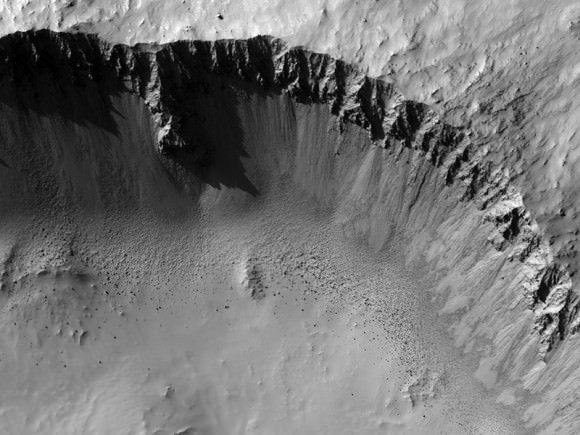
Source: HiRISE
Can We Land On a Comet?

The Rosetta mission will do something never before attempted: land on a comet. The spacecraft is now on its way to intercept comet 67P/Churyumov-Gerasimenko in January 2014 and land a probe on it for what promises to be an amazing view. But what we know of comets so far comes from a few flyby missions. So, with surface composition and conditions largely a mystery, so how did engineers prepare to land on something that could be either solid ice or rock, or a powdery snow or regolith – or something in between?
They had to design the Philae lander so it could land equally well on any surface. In the tiny gravitational field of a comet, landing on hard icy surface might cause Philae to bounce off again. Alternatively, hitting a soft snowy one could result in it sinking. To cope with either possibility, Philae will touch as softly as possible. In fact, engineers have likened it more to docking in space.
Philae will fire harpoons to secure itself to the comet; additionally, the landing gear is equipped with large pads to spread its weight across a broad area (kind of like snowshoes.)
While landing on a comet will certainly be nail-biting, having a front row seat for when the comet gets closer to the Sun is the most highly anticipated part of the mission.
[/caption]
“In some ways, a flyby is just a tantalizing glimpse of a comet at one stage in its evolution,” says Claudia Alexander, project scientist for the U.S. Rosetta Project at JPL. “Rosetta is different. It will orbit 67P for 17 months. We’ll see this comet evolve right before our eyes as we accompany it toward the Sun and back out again.”
We’ll be able to watch as it becomes “something poetic and beautiful, trailing a vast tail,” said Alexander. For once, we’ll be able to watch the surface of a comet transform in front of our eyes instead of relying on artist concept drawings! Additionally, the Rosetta spacecraft up above will be busy mapping the comet’s surface and magnetic field, monitoring the comet’s erupting jets and geysers, measuring outflow rates, and much more. Together, the orbiter and lander will build up the first 3-D picture of the layers and pockets under the surface of a comet.
Comets are considered a gold mine for astronomers who want to know what conditions were like back in the early days of our Solar System. And the data and images from this mission promises to be some of the most stunning we’ve yet seen.
Find out more about the Rosetta mission in the accompanying video, or see the ESA Rosetta website.
Source: Science@NASA
GRAIL Sends Back First Video of the Moon’s Far Side
A first look from GRAIL, showing the lunar far side! A camera aboard ‘Ebb’ — one of NASA’s twin Gravity Recovery And Interior Laboratory (GRAIL) lunar spacecraft has returned its first unique view of the far side of the Moon. The camera is the MoonKAM, which is part of a special program for students to study the Moon.
“The quality of the video is excellent and should energize our MoonKAM students as they prepare to explore the Moon,” said Maria Zuber, GRAIL principal investigator.
Continue reading “GRAIL Sends Back First Video of the Moon’s Far Side”
Casting Swords into Space Observatories
[/caption]
Editor’s note – Bruce Dorminey is a science journalist and author of Distant Wanderers: The Search for Planets beyond the Solar System.
Planet hunter extraordinaire Geoff Marcy recently let his frustration surface about the current state of the search for other habitable solar systems. Despite the phenomenal planet-finding success of NASA’s Kepler mission, Marcy, an astronomer at the University of California at Berkeley, correctly pointed out that NASA budget cuts have severely hampered the hunt for extrasolar life.
A decade ago, only a few dozen extrasolar planets had been detected. Today, by some recent gravitational microlensing estimates, there are more planets than stars in the Milky Way. But without the ability to characterize these extrasolar planetary atmospheres from space, we are astrobiologically hamstrung.
NASA’s goal had been that by 2020, we would have a pretty good idea about how frequently terrestrial Earth-mass planets orbit other stars — whether those planets have atmospheres that resemble our own; and, more crucially, whether those atmospheres exhibit the telltale signs of planets harboring life.
But consider how the federal government spends our tax dollars on a daily basis. Each and every day for more than a decade, the U.S. military spent roughly $1 billion a day funding congressionally-undeclared wars in Iraq and Afghanistan.
In contrast, NASA’s cancelled SIM and TPF missions were both originally estimated to have cost less than $1.5 billion dollars each.
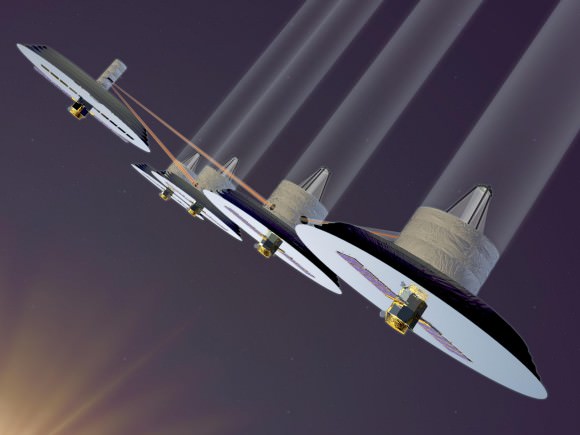
SIM, the Space Interferometry Mission, was to have focused on finding extrasolar earths in a targeted search; its follow-on mission, NASA’s TPF, the Terrestrial Planet Finder mission, was to have characterized the atmospheres of these earth twins in an attempt to remotely detect the signatures of life.
The astronomical community continues to be resourceful as it can in working around these problems. But if NASA had followed through with the SIM and TPF missions in the timeframe that it first announced, we would have a very good idea of our own earth’s galactic pecking order by now.
Instead, war-funding has taken priority. On the home front, we’ve let the attacks of 9/11 take us down a road that has resulted in our airports resembling Orwellian netherworlds. Most of us now accept that we must basically disrobe and be physically prodded before boarding an aircraft.
Kids born at the beginning of what was supposed to be a great new millennium — remember 2001: A Space Odyssey, anyone? — have instead grown up accustomed to running the gauntlet just to take their teddy bears onto the plane with them.
Contrast the country’s current poisoned national mood with the heady days of euphoria surrounding this country’s Moon shots.
Dare we attempt to again turn at least a portion of our swords back into ploughshares?
If the U.S. is going to continue to lead the world in science and technology, the country will have to quit living in a state of perpetual geopolitical paranoia and take space seriously again.
No one wants to turn a blind eye to our national defense and NASA may never return to its glory days. But something is amiss when within a generation, we’ve gone from John F. Kennedy pointedly challenging the nation to test its mettle by safely sending a man to the moon and back before the end of the decade to this current era of national teeth gnashing.
Newt Gingrich was openly ridiculed on the morning TV news shows for advocating that the U.S. use private enterprise to help us put a manned lunar colony on the moon. Mitt Romney responded that he’d fire any employee that walked into his office and suggested such a plan.
Perhaps Gingrich is not the ideal messenger for jumpstarting a long dormant manned lunar program. But our country has reached a sad nadir when a presidential candidate is publicly mocked for advocating the hard work of boldly revamping our national space policy.
IBEX Captures ‘Alien’ Material From Beyond Our Solar System

[/caption]
If we could board the starship Enterprise-D and were able to look through Giordi LaForge’s visor we might be able to see the interstellar medium – the ‘stuff’ between the stars — as wispy clouds of oxygen, hydrogen, helium and neon. Instead, since we are back in the 21st century, we have the Interstellar Boundary Explorer (IBEX) spacecraft, which has now made the first–ever direct observations of neutral hydrogen and oxygen atoms drifting into our solar system from the region outside our heliosphere. Surprisingly, this material is more ‘alien’ than scientists were expecting, as the matter in the galactic wind doesn’t contain the same exact material as what our solar system is made of.
The most important finding is there is less oxygen ‘out there.’ For every 20 neon atoms in the galactic wind, there are 74 oxygen atoms. In our own solar system, however, for every 20 neon atoms there are 111 oxygen atoms. That translates to more oxygen in any given region of the solar system than in the local interstellar space.
“Our solar system is different than the space right outside it and that suggests two possibilities,” said David McComas the principal investigator for IBEX. “Either the solar system evolved in a separate, more oxygen-rich part of the galaxy than where we currently reside or a great deal of critical, life-giving oxygen lies trapped in interstellar dust grains or ices, unable to move freely throughout space.”
Either way, the scientists said, this affects scientific models of how our solar system – and life – formed. And more than just helping to determine the distribution of elements in the interstellar medium, these new measurements provide clues about how and where our solar system formed, the forces that physically shape our solar system, and even the history of other stars in the Milky Way.
“This alien interstellar material is really the stuff that stars and planets and people are made of — and it’s very important to be measuring it directly,” McComas said during a press briefing on Tuesday.
If Spock were a member of this mission, he would probably raise an eyebrow and say, “Fascinating.”*
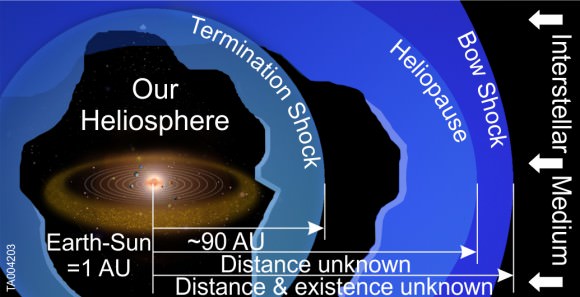
Interstellar clouds hold the elements of exploded supernovae, which are dispersed throughout the galaxy. As the interstellar wind blows these charged and neutral particles through the Milky Way, the spacecraft can measure samples that make it into our solar system. IBEX scans the entire sky once a year, and every February, its instruments point in the correct direction to intercept incoming neutral atoms. IBEX counted those atoms in 2009 and 2010 and has now captured the best and most complete glimpse of the material that lies so far outside our own system.
In addition to sampling the raw “star stuff,” the findings are important because the interstellar gas surrounding us can affect the strength of the Sun’s heliosphere – the area of influence by the Sun, and like a shielding bubble, protects us from dangerous galactic cosmic rays, the majority of which would come into the inner solar system if not for this bubble.
IBEX also discovered that the interstellar wind is approximately 7,000 miles per hour slower than previously thought. This indicates that our solar system is still in what’s referred to as the “local interstellar cloud.” However, the scientists noted that we will transition into a different region at any time within a few thousand years (very short on astronomical time scales) where conditions will change and affect the heliosphere’s protective capability. And no one knows if that change will be for the better or worse.
As our solar system travels around the Milky Way through the vast sweep of cosmic time, the ever-changing nature of the heliosphere has likely had implications on the evolution of life on Earth as varying levels of radiation spurred genetic mutations and, perhaps, wholesale extinctions.
“This is all very exciting, and it has important implications as the Sun moves through space and in and out of interstellar clouds , the flux of galactic cosmic rays varies,” said Priscilla Frisch, senior scientist, Department of Astronomy and Astrophysics at the University of Chicago, and part of the IBEX mission. “And that is recorded in the geo-isotopic records. Someday maybe we can link the Sun’s motion through interstellar clouds with geological records on Earth, and trace the geological history of Earth.”
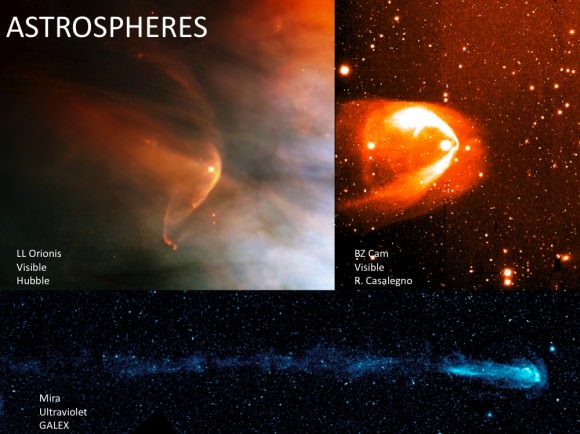
Additionally, while the new findings provide a greater understanding of our heliosphere, it will also aid scientists in exploring analogous structures called “astrospheres,” surrounding other stars throughout the galaxy.
“We know at least two cases of another star with a planetary system and an astrosphere around it, and these are the true analogs to our own solar system,” said Seth Redfield, assistant professor, Astronomy Department, Wesleyan University, in Middletown, Connecticut, also speaking at the press briefing. “The discovery of other planets coupled with our understanding of the impact these galactic cosmic rays could potentially have on planets and the emergence and evolution of life. These are connections that we haven’t explored fully, and with these new findings from IBEX, are now coming together to a very interesting topic to explore.”

IBEX is a small spacecraft, roughly the size of a card table, and is one of NASA’s low-cost missions. It is in Earth orbit, but can observe the edges of the solar system with detectors that “look” outward and collect particles called energetic neutral atoms. With data from IBEX, scientists are creating the first map of the boundary of our solar system.
These latest findings from IBEX were presented in a series of science papers appearing in the Astrophysics Journal on January 31, 2012.
“This set of papers provide many of the first direct measurements of the interstellar medium around us,” says McComas. “We’ve been trying to understand our galaxy for a long time, and with all of these observations together, we are taking a major step forward in knowing what the local part of the galaxy is like.”
For more information: NASA press release, Additional images, videos via Goddard Media Center, Papers: Disconnecting Solar Magnetic Flux, The Interstellar Boundary Explorer (IBEX): Tracing the Interaction between the Heliosphere and Surrounding Interstellar Material with Energetic Neutral Atoms,
*Thanks to Dwayne Brown from NASA for the Spock reference.
Phobos-Grunt Failure Due to Computer Problems, Cosmic Rays
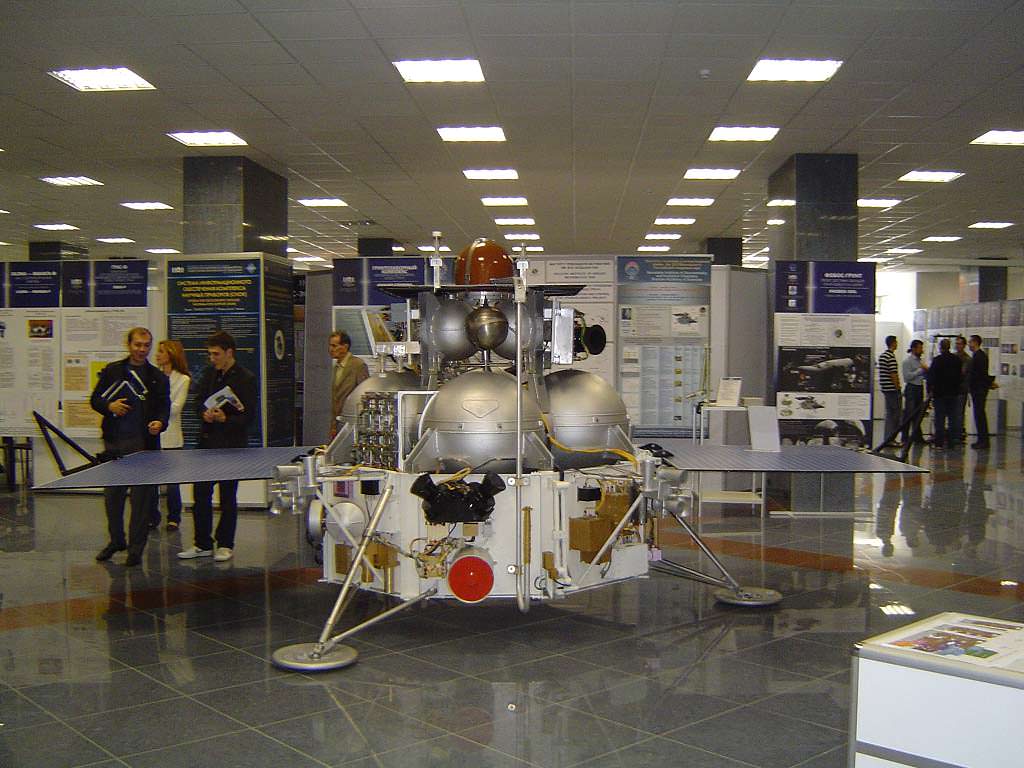
[/caption]
Roscosmos said today that a computer malfunction caused by cosmic rays was the reason for the failure of the Phobos-Grunt spacecraft. Additionally, ‘counterfeit’ chips in the computer may have played a role, said Federal Space Agency (Roscosmos) head Vladimir Popovkin. The original mission was to do a sample return from Mars’ largest moon, but the spacecraft crashed back to Earth on January 15 after the rocket failed to send it out of Earth orbit shortly after the launch in November. This determination comes from a study done by a commission led by Yuri Koptev, former head of the Russian Space Agency.
“There was a restart of the two sets of on-board computer system so [it] moved to the highest energy saving mode and the standby command,” said Popovkin, quoted by the Russian RIA Novosti news agency. “The most likely reason is the impact of heavy charged space particles.”
A Russian scientist was also quoted by RIA Novosti that the outcome of the accident investigation should not be cause for dismissals and resignations as much as a “lesson to developers of new interplanetary spacecraft,” said Alexander Zakharov, scientific secretary of Institute of Space Research, which developed instruments and the scientific program the station.
Some officials from Roscosmos had threatened the jobs of those involved with the mission.
As far as the counterfeit computer chips, Popovkin said the components were imported. “The cause probably is in this,” he said. Reportedly, NASA and the U.S. Defense Department has also encountered counterfeit products, according to an article in Itar-Tass.
Anatoly Zak at RussianSpaceWeb.com reported more in detail about possible shortcomings in the design of the probe’s flight control system, called the BKU, saying that “the most likely culprit in the failure of the probe’s propulsion unit to ignite soon after it had entered orbit on November 9 was a programming error in the flight control system.”
Zak said an industry source revealed that the commission studying the failure “concluded that the mission failure was the result of the design error and the lack in the ground testing of BKU,” adding that “its shortcomings had been well documented long before the ill-fated launch.” The BKU was the the main computer and the “brain” of the spacecraft.
Additionally, Zak reported that the most probable cause was a “simultaneous robooting of two operational processors in the main computer” and the computers “could crash as a result of errors in their software or as a result of some external reasons, such as electromagnetic incompatibility,” industry sources said.
The assertion that “foreign radars” had possibly caused the malfunction was apparently tested by the company that built the Phobos-Grunt probe, NPO Lavochkin, with no problems coming from simulated radar interference.
“With all external failure scenarios effectively debunked, the most probable cause of the failure was narrowed down to the lack of integrated testing,” Zak reported.
Roscosmos also indicated they may try again to send a sample return mission to Phobos.
As to the probability of any pieces of the original Phobos-Grunt spacecraft surviving the fiery re-entry through Earth’s atmosphere, most experts agree that most of the debris ended up in the Pacific Ocean. However, some debris may have fallen onto regions of Chile and possibly Argentina.
Luciano Anselmo from the Space Flight Dynamics Laboratory (ISTI/CNR) in Pisa, Italy left a comment on a previous Universe Today article saying that the Phobos-LIFE capsule, which was designed to survive re-entry “should have impacted the ground approximately 820 km eastward along the trajectory and 15 minutes later (w.r.t. the 80 km ‘entry’ point), with a velocity around 70 km/h.”
However, Anselmo added that “based on the orbit data available from the different sources involved, our estimation of the final uncertainty is plus/minus 12 minutes. Other observations, or the lack of them, both from the ground or from space, might be used to reduce such uncertainty, but nothing of reliable and unclassified has been provided so far, to my knowledge.”
Sources: RIA Novosti, RussianSpaceWeb.com, Itar-Tass
NASA’s New Eyes in the Sky
[/caption]
On March 14, NASA will launch the Nuclear Spectroscopic Telescope Array or NuSTAR. This is the first time a telescope will focus on high energy X-rays, effectively opening up the sky for more sensitive study. The telescope will target black holes, supernova explosions, and will study the most extreme active galaxies. NuSTAR’s use of high-energy X-rays have an added bonus: it will be able to capture and compose the most detailed images ever taken in this end of the electromagnetic spectrum.
NuSTAR’s eyes are two Wolter-I optic units; once in orbit each will ‘look’ at the same patch of sky. The Wolter-I mirror works by reflecting an X-ray twice, once off of an upper mirror shaped like a parabola and again off a lower mirror shaped like a hyperbola. The mirrors are nearly parallel to the direction of the incoming X-ray, reflecting most of the X-ray instead of absorbing it, but the slight angle allows for a very small collection area per surface. To get a full picture, mirrors of varying size are nested together.
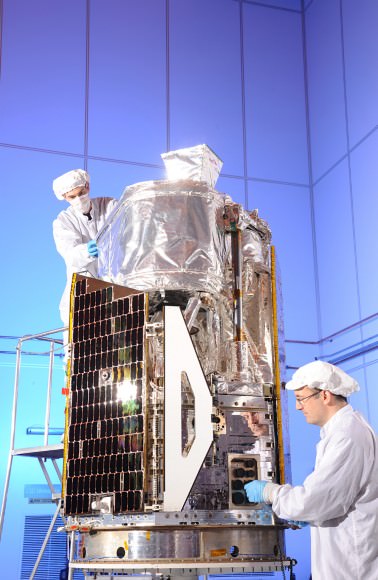
Each of NuSTAR’s eyes, each unit, are made of 133 concentric shells of mirrors shaped from flexible glass like that found in laptop computer screens. This is an improvement over past missions like Chandra and XMM-Newton that both used high density materials such as Platinum, Iridium and Gold as mirror coatings. These materials achieve great reflectivity for low energy X-rays but can’t capture high energy X-rays.
Like human eyes, NuSTAR’s optical units are co-aligned to give the telescope a wider field of view and enable the capture of more sensitive images. These images will be made into detailed composites by scientists on the ground.
Also like human eyes, NuSTAR’s optical units need to be distanced from one another since X-ray telescopes require long focal lengths. In other words, the optics must be separated by several meters from the detectors. NuSTAR does this with a 33 foot (10 metre) long mast or boom between units.
Previous X-ray missions have accommodated these long focal lengths by launching fully deployed observatories on large rockets. NuSTAR won’t. It has a unique deployable mast that will extend once the payload is in orbit. This allows for a launch on the small Pegasus rocket. Undeployed, the telescope measures just 2 metres in length and one metre in diameter.
During its two-year primary mission, NuSTAR will map the celestial sky focussing on black holes, supernova remnants, and particle jets traveling near the speed of light. It will also look at the Sun. Observations of microflares could explain the temperature of the Sun’s corona. It will also search the Sun for evidence of a hypothesized dark matter particle to test a theory about dark matter.
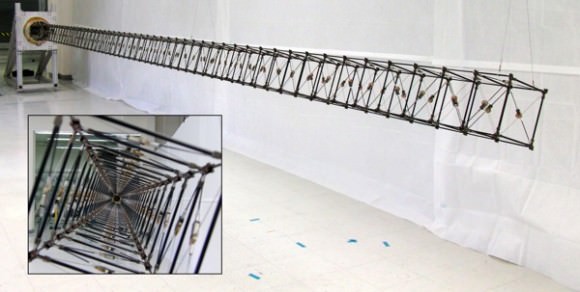
“NuSTAR will provide an unprecedented capability to discover and study some of the most exotic objects in the universe, from the corpses of exploded stars in the Milky Way to supermassive black holes residing in the hearts of distant galaxies,” said Lou Kaluzienski, NuSTAR program scientist at NASA Headquarters in Washington.
The telescope shipped from the Orbital Sciences Corporation in Dulles, Virginia to Vandenberg Air Force Base in California on January 27. There, it will be mated to its Pegasus launch vehicle on February 17. It will launch from underneath the L-1011 “Stargazer” aircraft on March 14 after taking off near the equator from Kwajalein Atoll in the Pacific.
Source: NASA
